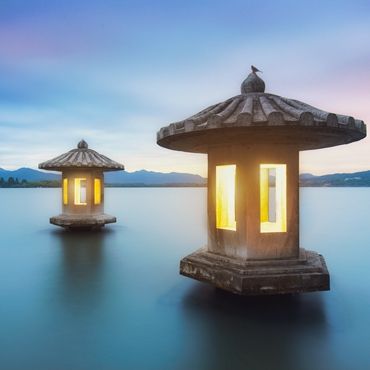The Huangpu River
The Huangpu River is a landmark waterway in Shanghai, stretching approximately 113 kilometers (about 70 miles) in length with a width ranging from 300 to 770 meters (about 984 to 2526 feet). Its drainage basin covers an area of 24,000 square kilometers (approx. 5,930,530 acres).

The river originates from Dianshan Lake in Zhujiajiao Town, Qingpu District, which receives water from the upper reaches of the Taihu Lake basin. From there, the river flows downstream to Wusongkou, where it meets the Yangtze River before flowing into the East China Sea. Over the course of thousands of years, the river has carved its path, with the upper reaches running east to west, and the middle and lower reaches turning north to south, effectively dividing the city of Shanghai into Puxi (West of the Huangpu River) and Pudong (East of the Huangpu River). On either side of the river, Shanghai’s most iconic landmarks have risen: the historic Bund on the west bank and the modern financial district of Lujiazui on the east.
During a visit to the river, tourists can admire the Yangpu Bridge, the Nanpu Bridge, and the Oriental Pearl Tower, which stands in the heart of the city. The two bridges, resembling two giant dragons stretching across the Huangpu River, frame the Oriental Pearl Tower in the center, creating a stunning visual metaphor of "two dragons playing with a pearl."
On the west bank of the Huangpu River, visitors are greeted by a collection of grand, foreign-style buildings, known for their diverse architectural influences from around the world. On the east bank, in stark contrast, towering modern skyscrapers rise into the sky, symbolizing Shanghai’s rapid development into a global financial hub.
Wusongkou, located at the mouth of the river, marks the point where the Huangpu River converges with the Yangtze River and the East China Sea. During high tide, one can witness the famous "Three-Water Convergence" phenomenon, where the Huangpu River’s bluish-gray waters, the muddy yellow waters of the Yangtze, and the green waters of the East China Sea mix together, creating a striking display of yellow, green, and blue hues.
The Huangpu River serves multiple functions: it is vital for shipping, water supply, drainage, irrigation, and tourism. As one of the world’s most renowned rivers, it is both a product of nature’s transformative power and a testament to humanity’s successful practice of harnessing the river’s natural flow to serve the needs of a growing city.
















